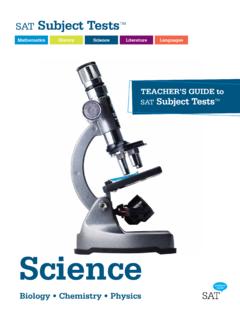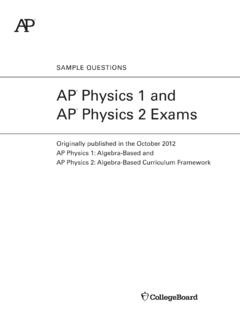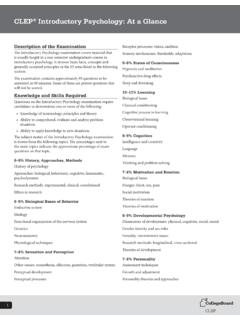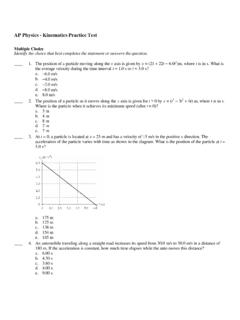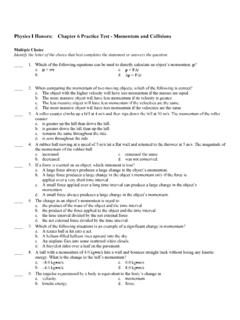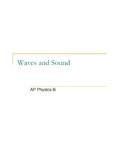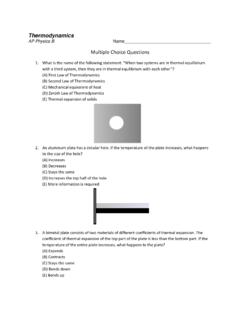Transcription of A P Physics B 2014 Free-Response Questions
1 AP Physics B 2014 Free-Response Questions 2014 The College Board. College Board, Advanced Placement Program, AP, AP Central, and the acorn logo are registered trademarks of the College Board. Visit the College Board on the Web: AP Central is the official online home for the AP Program: C -2- TABLE OF INFORMATION, EFFECTIVE 2012 CONSTANTS AND CONVERSION FACTORS Proton mass, kgpm-= Neutron mass, kgnm-= Electron mass, 10 kgem-= Avogadro s number, molN= Universal gas constant, J (mol K)R=i Boltzmann s constant, KBk-= Electron charge magnitude, Ce-= 1 electron volt,191 J-= Speed of light, m sc= Universal gravitational constant, m kg sG-= i Acceleration due to gravityat Earth s surface, m sg= 1 unified atomic mass unit,2721 kg931 MeVc-= = Planck s constant,= J s= 1015i eV s = = J m= 103i eV nm iVacuum permittivity, N m-= i Coulomb s law constant, 10 Nm Ckp== i 2 Vacuum permeability,70410 (Tm)mp-= i AMagnetic constant, 704110 (Tm)
2 Kmp-== i A 1 atmosphere pressure,521 N Pa= = meter,mmole,molwatt,Wfarad,Fkilogram,kgh ertz,Hzcoulomb,Ctesla,Tsecond,snewton,Nv olt,Vdegree Celsius,ampere,Apascal,Paohm,W electron-volt,eVUNIT SYMBOLS kelvin,Kjoule,Jhenry,HPREFIXES FactorPrefixSymbol109gigaG106megaM103kil ok10-2centic10-3millim10-6micro m10-9nanon10-12picopVALUES OF TRIGONOMETRIC FUNCTIONS F OR COMMON ANGLESq0D30D37D45D53D60D90 Dsinq0 12 35 22 45 32 1 cosq1 32 45 22 35 12 0 tanq0 33 34 1 433 The following conventions are used in this exam. I. Unless otherwise stated, the frame of reference of any problem is assumed to be inertial. II. The direction of any electric current is the direction of flow of positive charge (conventional current). III. For any isolated electric charge, the electric potential is defined as zero at an infinite distance from the charge.
3 IV. For mechanics and thermodynamics equations, W represents the work done on a system. -3- ADVANCED PLACEMENT Physics B EQUATIONS, EFFECTIVE 2012 NEWTONIAN MECHANICS ELECTRICITY AND MAGNETISM 0atuu=+ 20012xxtatu=+ + (2202ax xuu=+ - )0netm = =FFa fricFNm 2caru= sin rtq=F m=pv tDD==J Fp 212 Kmu= gUmD= ghcosWFrqD= avgWPtD= PFcosuq= sk=-Fx 212sUkx= 2smTkp= 2pTgp=A 1Tf= 122 GGm mFr=- 12 GGm mUr=- a = acceleration F = force f = frequency h = height J = impulse K = kinetic energy k = spring constant A = length m = mass N = normal force P = power p = momentum r = radius or distance T = period t = time U = potential energy u = velocity or speed W = work done on a system x = position m = coefficient of friction q = angle t = torque 212=kq qFr q=FE 12==Ekq qUqVr avgVEd=- =++ qqqVkrr r + QCV= 0 ACd= 21122cUQVCV== avgQItDD= RAr=A VIR= PIV= +++pCCCC +++sCCCC +++sRRRR +++pRRRR sinBFqBuq= sinBFBIq=A 02 IBrmp= cosmBAfq= mtfeDD=-avg Bue=A A =
4 Area B = magnetic field C = capacitance d = distance E = electric field e = emf F = force I = current A = length P = power Q = charge q = point charge R = resistance r = distance t = time U = potential (stored) energy V = electric potential or potential difference u = velocity or speed r = resistivity q = angle mf = magnetic flux -4- ADVANCED PLACEMENT Physics B EQUATIONS, EFFECTIVE 2012 FLUID MECHANICS AND THERMAL Physics WAVES AND OPTICS mVr= 0PP ghr=+ buoyFVgr= 112 2 AAu= u21 ++ = 0 TaDD=AA kA THLD= FPA= BPVnRTNk T== 32avgBKk=T33 BrmskTRTMum== WPD=- VUQWD=+ HWeQ= HCcHTTeT-= A = area e = efficiency F = force h = depth H = rate of heat transfer k = thermal conductivity Kavg = average molecular kinetic energy A = length L = thickness m = mass M = molar mass n = number of moles N = number of molecules P = pressure Q = heat transferred to a system T = temperature U = internal energy V= volume u = velocity or speed rmsu= root-mean-square velocity W = work done on a system y = height a = coefficient of linear expansion m = mass of molecule r = density ful= cnu= 112 2sinsinnnq= q21sinncnq= 011 1ssfi+=
5 00iiMhs==- hs2Rf= sindmql= l mLxmd d = separation f = frequency or focal length h = height L = distance M = magnification m = an integer n = index of refraction R = radius of curvature s = distance u = speed x = position l = wavelength q= angle ATOMIC AND NUCLEAR Physics Ehfpc== maxKhff=- hpl= 2()EmcDD= E = energy f = frequency K = kinetic energy m = mass p = momentum l= wavelength f= work function GEOMETRY AND TRIGONOMETRY Rectangle Abh= Triangle 12 Abh= Circle 2 Arp= 2 Crp= Rectangular Solid Vw=A hCylinder 2 Vrp=A 222 Srpp=+A rSphere 343 Vrp= 24 Srp= Right Triangle 22 2ab c+= sinacq= cosbcq= tanabq= A = area C = circumferenceV = volume S = surface area b = base h = height A = length w = width r = radius cab90 q 2014 AP Physics B Free-Response Questions 2014 The College Board.
6 Visit the College Board on the Web: GO ON TO THE NEXT PAGE. -5- Physics B SECTION II Time 90 minutes 7 Questions Directions: Answer all seven Questions , which are weighted according to the points indicated. The suggested times are about 17 minutes for answering each of Questions 1 and 5, and about 11 minutes for answering each of Questions 2-4 and 6-7. The parts within a question may not have equal weight. Show all your work in this booklet in the spaces provided after each part. 1. (15 points) Starting from rest at point A, a 50 kg person swings along a circular arc from a rope attached to a tree branch over a lake, as shown in the figure above. Point D is at the same height as point A. The distance from the point of attachment to the center of mass of the person is m. Ignore air resistance and the mass and elasticity of the rope.
7 (a) The person swings two times, each time letting go of the rope at a different point. i. On the first swing, the person lets go of the rope when first arriving at point C. Draw a solid line to represent the trajectory of the center of mass after the person releases the rope. ii. A second time, the person lets go of the rope at point D. Draw a dashed line to represent the trajectory of the center of mass after the person releases the rope. 2014 AP Physics B Free-Response Questions 2014 The College Board. Visit the College Board on the Web: GO ON TO THE NEXT PAGE. -6- (b) The center of mass of the person standing on the platform is at point A, m above the surface of the water. Calculate the gravitational potential energy when the person is at point A relative to when the person is at the surface of the water.
8 (c) The center of mass of the person at point B, the lowest point along the arc, is m above the surface of the water. Calculate the person s speed at point B. (d) Suppose that the person swings from the rope a third time, letting go of the rope at point B. Calculate R, the horizontal distance moved from where the person releases the rope at point B to where the person hits the water. (e) If the person does not let go of the rope, how does the magnitude of the person s momentum Cp at point C compare with the magnitude of the person s momentum Bp at point B ? ____ CBpp> ____ CBpp< ____ CBpp= Provide a physical explanation to justify your answer. 2014 AP Physics B Free-Response Questions 2014 The College Board. Visit the College Board on the Web: GO ON TO THE NEXT PAGE. -7- 2.
9 (10 points) A cube of mass m and side length L is completely submerged in a tank of water and is attached to the bottom of the tank by a string, as shown in the figure above. The tension in the string is times the weight of the cube. The density of water is 1000 kg/m3. (a) On the dot below that represents the cube, draw and label the forces (not components) that act on the cube while it is attached to the string. Each force must be represented by a distinct arrow starting on, and pointingaway from, the dot. (b) Calculate the density of the cube. (c) The string is now cut. Calculate the magnitude of the acceleration of the cube immediately after the string is cut. If you need to draw anything other than what you have shown in part (a) to assist in your solution, use the space below. Do NOT add anything to the figure in part (a).
10 (d) Indicate whether the magnitude of the buoyant force on the cube increases, decreases, or remains the same while the cube is rising, but before it reaches the surface. ____ Increases ____ Decreases ____ Remains the same Justify your answer. 2014 AP Physics B Free-Response Questions 2014 The College Board. Visit the College Board on the Web: GO ON TO THE NEXT PAGE. -8- 3. (10 points) A sample containing three moles of an ideal gas is taken through a series of equilibrium states, as represented by the closed path ABCDA in the diagram above. (a) i. Rank the temperatures at the 4 labeled points from least to greatest, using 1 for the lowest temperature. If two or more points have the same temperature, give them the same ranking. ____ A ____ B ____ C ____ D ii.
